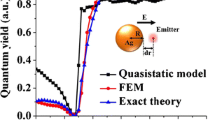Abstract
The rate of annihilation delayed fluorescence of organic molecules localized on the surface of a layered spherical nanoparticle is calculated based on an original mathematical model on the assumption that one of the molecules remains stationary, while the other diffusively moves over the particle surface. A composite nanoparticle consists of a ferromagnetic (cobalt, nickel, or magnetite) core and a metal (Au or Ag) plasmon shell. Not only is the external uniform magnetic field into which the particle was placed taken into account, but also a nonuniform anisotropic magnetic field, formed by the ferromagnetic core of the composite, in the outer surface region of the particle. The predominant influence of the structural and geometric parameters of the system (the ratio of core radius to shell thickness) on the delayed fluorescence rate of molecules as a result of a plasmon increase/decrease in the radiative transition probability (more than 30%) is shown. The manifestation of the magnetic factor in the rate of the triplet–triplet annihilation reaction is less pronounced (about 10%). The obtained delayed fluorescence spectra of the layered ferroplasmonic nanocomposite with silver and gold shells demonstrate a clear dependence of the signal amplitude on the shell material and thickness.










Similar content being viewed by others
REFERENCES
W. Brullot et al., Nanomedicine 8 (5), 559 (2012). https://doi.org/10.1016/j.nano.2011.09.004
E. R. Riva et al., J. Colloid Interface Sc. 502, 201 (2017). https://doi.org/10.1016/j.jcis.2017.04.089
M. Runowski et al., J. Alloys Compd. 762, 621 (2018). https://doi.org/10.1016/j.jallcom.2018.05.211
S. Baluschev et al., Nano Lett. 5 (12), 2482 (2005). https://doi.org/10.1021/nl0517969
K. Poorkazem et al., J. Phys. Chem. C 118, 6398 (2014). https://doi.org/10.1021/jp412223m
X. Cao et al., Phys. Chem. Chem. Phys. 17, 14479 (2015). https://doi.org/10.1039/C5CP01876E
L. Wang et al., Nano Lett. 11 (3), 1237 (2011). https://doi.org/10.1021/nl1042243
A. Mayoral et al., Chem. Commun. 51, 8442 (2015). https://doi.org/10.1039/C5CC00774G
H.-Y. Park et al., Langmuir 23 (17), 9050 (2007). https://doi.org/10.1021/la701305f
X. Gao et al., Sci. Rep. 10, 1365 (2020). https://doi.org/10.1038/s41598-020-58403-x
H. She et al., J. Mater. Chem. 22, 2757 (2012). https://doi.org/10.1039/C1JM14479K
P. Bhatia et al., Phys. Lett. A 383 (21), 2542 (2019). https://doi.org/10.1016/j.physleta.2019.05.009
B. Wang et al., Appl. Surf. Sci. 292, 1002 (2014). https://doi.org/10.1016/j.apsusc.2013.12.103
Sh. Izakura et al., J. Phys. Chem. C 122 (26), 14425 (2018). https://doi.org/10.1021/acs.jpcc.8b05508
T. Sun et al., Chem. Asian J. 13 (4), 373 (2018). https://doi.org/10.1002/asia.201701660
G. Chen et al., Chem. Soc. Rev. 44, 1680 (2015). https://doi.org/10.1039/C4CS00170B
X. Chen et al., Chem. Soc. Rev. 44, 1318 (2015). https://doi.org/10.1039/C4CS00151F
Ch. Duan et al., J. Mater. Chem. B 6, 192 (2018). https://doi.org/10.1039/C7TB02527K
P. P. Neyasov, M. G. Kucherenko, and I. R. Alimbekov, Annihilation delayed fluorescence of organic molecules in nanoreactors with ferromagnetic particles, in Proc. 9th Russian-Japanese Conf. “Chemical Physics of Molecules and Polyfunctional Materials” (IPK Universitet, Orenburg, 2018), p. 38.
M. G. Kucherenko, I. R. Alimbekov, and P. P. Neyasov, Spin-selective cross-annihilation of electronic states of mobile triplet molecules on the surface of a ferromagnetic nanoparticle, in Proc. All-Russian Sci.-Method. Conf. “University Complex as a Regional Center of Education, Science, and Culture” (Orenburg State Univ., Orenburg, 2019), p. 2896 [in Russian].
M. G. Kucherenko and P. P. Neyasov, Khim. Fiz. Mezoskop. 20 (1), 33 (2018).
M. G. Kucherenko and V. M. Nalbandyan, Phys. Procedia 73, 136 (2015). https://doi.org/10.1016/j.phpro.2015.09.134
V. M. Nalbandyan, E. V. Seliverstova, D. A. Temirbayeva, M. G. Kucherenko, and N. H. Ibrayev, Plasmon-activated processes in a hybrid molecular cluster with a spherical nanoparticle, in Proc. 11th Int. Conf. “Chaos and Structures in Nonlinear Systems” (Karaganda State Univ., Karaganda, Kazakhstan, 2018), p. 128.
M. G. Kucherenko, I. R. Alimbekov, and P. P. Neyasov, Features of annihilation delayed fluorescence of organic molecules near a spherical ferroplasmonic nanocomposite, in Proc. All-Russian Sci.-Method. Conf. “University Complex as a Regional Center of Education, Science, and Culture” (Orenburg State Univ., Orenburg, 2020), p. 2222.
V. V. Klimov, Nanoplasmonics (Pan Stanford, Singapore, 2014).
G. V. Meledin and V. S. Cherkasskii, Electrodynamics in Problems. Part 1: Electrodynamics of Particles and Fields. Chap. 5: Magnetostatics in Matter (Novosibirsk State Univ., Novosibirsk, 2003) [in Russian].
M. G. Kucherenko and R. N. Dusembaev, Chem. Phys. Lett. 487, 58 (2010).
P. W. Atkins and G. T. Evans, Mol. Phys. 29 (3), 921 (1975).
M. G. Kucherenko and V. M. Nalbandyan, Opt. Spectrosc. 128 (11), 1910 (2020).
P. P. Neyasov, I. R. Alimbekov, and M. G. Kucherenko, Formation of pulses of cross-annihilation delayed fluorescence of molecules in nanoreactors with magnetite particles, in Proc. 7th Int. Conf. on Photonics and Informatation Optics (Nat. Res. Nucl. Univ. MEPHI, Moscow, 2019), p. 467.
Funding
This study was supported by the Ministry of Science and Higher Education of the Russian Federation within the framework of research project no. FSGU-2020-0003.
Author information
Authors and Affiliations
Corresponding author
Ethics declarations
The authors declare that they have no conflicts of interest.
Additional information
Translated by A. Sin’kov
Rights and permissions
About this article
Cite this article
Kucherenko, M.G., Alimbekov, I.R. & Neyasov, P.P. Delayed Fluorescence of Molecules on the Surface of a Layered Ferroplasmonic Nanoparticle. Tech. Phys. 67, 632–643 (2022). https://doi.org/10.1134/S106378422209002X
Received:
Revised:
Accepted:
Published:
Issue Date:
DOI: https://doi.org/10.1134/S106378422209002X




